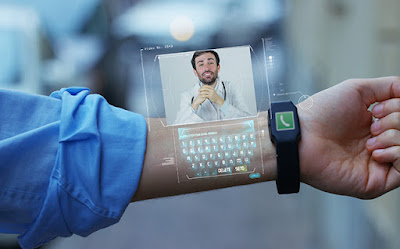A decade ago, the disruptive technologies we have now were unimaginable. Sure, we had the concept of artificial intelligence and robotics back then, but the sophistication those technologies now have was unfathomed. In contrast, imagine the scenario a decade in the future. Will we live like the Jetsons with flying cars? Will food scarcity end with floating farms? Will we live in smart-bio bubbles? The possibilities are endless, but practically there are some cool innovations that might become reality. Excited?
1. Artificial eyes
Bionic eyes have been a mainstay of science fiction for decades, but now real-world research is beginning to catch up with far-sighted storytellers. A raft of technologies is coming to market that restore sight to people with different kinds of vision impairment.
In January 2021, Israeli surgeons implanted the world’s first artificial cornea into a bilaterally blind, 78-year-old man. When his bandages were removed, the patient could read and recognise family members immediately. The implant also fuses naturally to human tissue without the recipient’s body rejecting it.
Likewise in 2020, Belgian scientists developed an artificial iris fitted to smart contact lenses that correct a number of vision disorders. And scientists are even working on wireless brain implants that bypass the eyes altogether.
Researchers at Montash University in Australia are working on trials for a system whereby users wear a pair of glasses fitted with a camera. This sends data directly to the implant, which sits on the surface of the brain and gives the user a rudimentary sense of sight
2. Smart Toothbrushes
One thing that will probably never change is our aversion to visiting the dentist. However, futuristic toothbrushes will be designed to send data directly to your dentist.
Sensors in the toothbrush will be able to scan for cavities and the build-up of plaque so that you can prevent tooth decay and gum disease.
3. Artificial Neurons and Medical Treatment
Artificial neurons represent the first legitimate way to reproduce the electrical properties of actual neurons.
Why does this matter? Neurons transmit critical information throughout your body. Neurological problems occur when there is a disruption of this communication. The development of artificial neurons, and a legitimate way to implant them in the body, could revolutionize the way we treat disease in the future.
Here’s how it works:
Step 1: Create an artificial neuron.
Step 2: Attach neuron to a silicon microchip.
Step 3: Create implantable devices that can be used to treat and even reverse degenerative conditions such as Alzheimer’s and heart failure.
4. 3D printed bones
3D printing is an industry promising everything from cheap house building through to affordable rugged armour, but one of the most interesting uses of the technology is the building of 3D printed bones.
The company Ossiform specialises in medical 3D printing, creating patient-specific replacements of different bones from tricalcium phosphate – a material with similar properties to human bones.
Using these 3D printed bones is surprisingly easy. A hospital can perform an MRI which is then sent to Ossiform who create a 3D model of the patient-specific implant that is needed. The surgeon accepts the design and then once it is printed, it can be used in surgery.
What is special about these 3D printed bones is that because of the use of tricalcium phosphate, the body will remodel the implants into vascularised bone. That means they will enable the full restoration of function that the bone it is replacing had. To achieve the best integration possible, the implants are of a porous structure and feature large pores and canals for cells to attach to and reform bone.
5. Drone ecosystem
Drones are slowly taking over especially for surveillance and mapping purposes. Military applications of drones are also being highly sought after.
And now companies like Amazon and Jubilant Foodworks are employing drones for the delivery of goods and pizzas respectively.
This is quite an insight into the future as drones might form the basic ecosystem of the entire logistics industry by 2050.
6. Natural language Processing
Natural language processing is the big new trend taking over the internet. While you've most likely seen it in use in Google's autocomplete software, or when your smartphone offers a prediction of what you are trying to type, it is capable of much smarter things.
OpenAI is a company that is at the forefront of artificial intelligence, originally taking the internet by storm with its image generator Dall-E 2. Now it is back, making a chatbot known as ChatGPT, creating poems from scratch, explaining complex theories with ease and having full-length conversations like it is a human.
ChatGPT is powered by a software known as GPT-3, trained on billions of examples of texts, then taught how to form coherent and logical sentences.
ChatGPT is an example of AI and its future. It has proven its ability to make completely new websites from scratch, write entire length books and even make jokes... although, it clearly still hasn't mastered humour yet.
7. Self-driving cars because of Future Technology
Here a popular future technology idea that is being widely researched and nearing implementation on a full scale.
Self-driving cars have received a major boost owing to multiple positives that it arrives with. With machines taking over, a seamless ecosystem of such cars can emerge that can result in fewer accidents, quicker transit times, and lower human fatigue which further impacts business productivity positively.
There is also the advertising opportunity where humans not involved in concentrating on the driving aspect can concentrate on the advertising boards


.jpg)










0 Comments